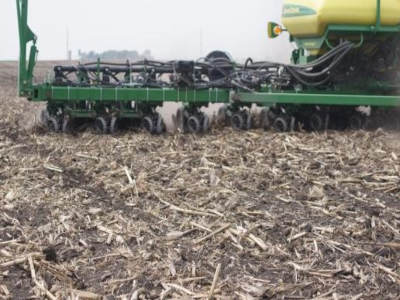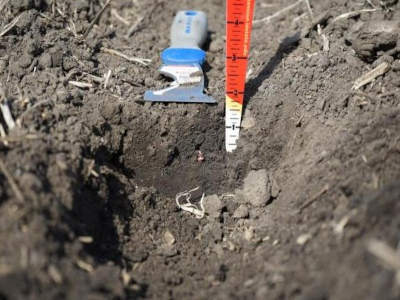By Levi Powell and Ryan Bergman
Spring planting season may come with added challenges as growers continue to deal with the effects of last August’s derecho event. Many fields through central Iowa were riddled with downed corn, and while some fields were able to be partially harvested, others were damaged so severely that growers had no choice but to till them under without harvesting any grain. In either case, there will be higher than normal residue levels in these fields this spring. This added residue load, combined with predicted dry conditions for this spring and summer, will require more attention and adjustment during planting and leave many growers rethinking their usual spring field work plans.
Planting into no-till soil conditions is common in many parts of Iowa. However, some parts of the state still rely on tillage to dry out heavy, wet soils and warm up the soil faster in early spring. With the potential for a dry spring and summer this season, some farmers that would normally rely on tillage practices to dry soils out may be looking to no-till planting as a way to conserve soil moisture.
Here are some key points for to consider as you gear up for planting this spring in these predicted conditions.
Residue Management
While many growers who regularly plant in no-till or high residue conditions have customized planter setups for their specific needs, you can still plant into high residue or no-till fields with a planter that normally operates in conventional tillage.

Figure 1. Inspect the furrow periodically during planting to ensure your planter is performing effectively in high residue areas. If disk openers and row cleaners are not working effectively, seeds may not reach the correct planting depth.
Row cleaners help to clear surface residue out of the way of disk openers and prevent residue from getting into the seed furrow. Your planter may already be equipped with a row cleaner system, or you may be considering installing one for this season. If so, be sure to monitor the performance regularly. The higher residue loads this season may require slightly more aggressive settings than normal. The goal is for the row cleaner to move all surface residue out of the path of the row unit without disturbing the soil surface or digging too much of a trench ahead of the row unit.
If your planter does not have row cleaners it is still possible to plant in high residue conditions, but it may take more patience and adjustments. Check the disk openers on your planter. A pair of sharp and properly adjusted disk openers will be able to cut through surface residue and move it off to the side of the furrow. If your disk openers are worn, you may consider replacing them before the start of the season. It is also important to pay close attention to the moisture of the residue in the field. If the residue is dry it will be cut easily by the disk openers, but if it is damp or wet from dew or rain then you will have to wait for it to dry out. This may mean waiting to start planting until later in the day when the sun and wind have had time to dry out the surface residue.
Throughout the day, inspect the seed furrow as well as residue on the soil surface around the seed furrow. The residue should be cut cleanly. If residue is not being cut by the disk openers you will see it being pressed down and pinned into the furrow.
- Shifting the Guidance Line
This is one of the simplest steps to managing residue and is a common practice for many growers. Shifting the guidance line by half a row width will allow the planter row units to run in between last year’s corn or soybean rows, reducing the amount of larger stalk material that the row unit will have to travel through.
Other Machine Adjustments
Higher downforce will help the disk openers cut through residue more consistently. In no-till conditions, higher down force will be needed to penetrate the soil and keep the row unit in contact with the ground. The resistive force of the soil varies in no-till conditions, and the downforce system will need to compensate for that as the planter moves through the field. Automatic pneumatic or hydraulic down force systems will be a benefit in these conditions as they can more rapidly adjust the applied downforce in response to changing soil resistance as the row units move through the field. Check out this video from spring 2020 for more tips on setting planter downforce to meet your planting goals.
The closing system will also require higher force in no-till and high residue conditions. You may need to run one or two notches heavier on closing force than you would in a normally tilled field. Check the furrow closing quality and be sure that all air pockets are being closed up and that the furrow is closed completely from the bottom of the trench to the soil surface. The best technique for checking this is to use a small trowel to cut crossways through the furrow and drag the soil back. This will provide a cross section view of the furrow to evaluate how well it closed.

Figure 2. Digging the furrow allows you to evaluate how well it is being closed up by the planter. Using a putty knife or a small paint scraper, you can cleanly slice the furrow and provide a good profile view to check for adequate furrow closing, depth, and moisture.
There are many options for closing wheel systems on the market. More aggressive dimpled or small spike closing wheels may provide an advantage in difficult furrow closing conditions. Check with your dealer or seed salesman, or other growers in your area to find a closing system that people have had success with.
If row cleaners, the down force system, or the closing system are struggling to maintain job quality in more challenging no-till conditions, it may be beneficial to slow the ground speed by 1 to 1.5 miles per hour. This reduction in ground speed will give the systems more time to react to changes and maintain their performance across the field.
Managing Soil Moisture
With dry spring conditions predicted it will be important to pay close attention to soil moisture at the time of planting. Making sure all seeds are placed into moisture is a deciding factor in ensuring even emergence across a field. It will be important to dig and verify where the moisture line is in each field at the time of planting. The moisture line may vary more in no-till fields, so it’s crucial to dig and check the moisture line in the soil at multiple landscape positions in the fields; for example, the highest areas of the field, and lowest areas of the field.
The part of the field with the deepest moisture line should be the determining factor for how to set planting depth. This will ensure that seeds are placed below or at the moisture line. If conditions are dry and minimal rain is forecasted, then the optimal planting depth may very well be half an inch to three-quarters of an inch deeper than your normal planting depth.
Making the decision to plant a field as no-till can help conserve moisture in the top few inches of soil, but it comes with several considerations in terms of machine settings and equipment. Follow these guidelines to make the best decision for your operation and ensure all your seeds are planted into moisture this spring.
Source : iastate.edu